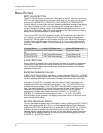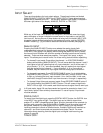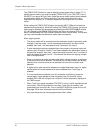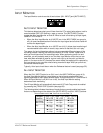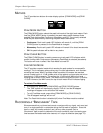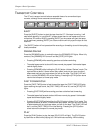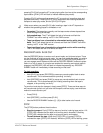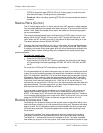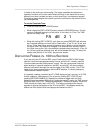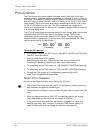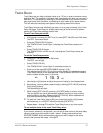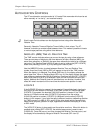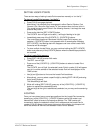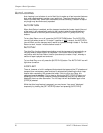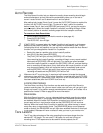
Chapter 4: Basic Operations
44 ADAT XT Reference Manual
[STOP] to thread the tape ([STOP] LED is lit). Entering play or record more will
also thread the tape, if it was previously unthreaded.
• Punch out. When recording, pressing [STOP] will exit record mode and stop the
transport.
SAMPLE RATE (CLOCK)
The XT records digital audio in a similar manner as a DAT recorder or digital sampler.
You may select between two sample rates when using the XT’s internal clock: 48 kHz
and 44.1 kHz. Select the sample rate to match the balance of the recording system
you are connected to.
The currently selected sample rate is indicated by the CLOCK group of icons in the
display. When the INT and 44.1K icons are lit, the XT is set to an internal 44.1 kHz
clock. When the INT and 48K icons are lit, the internal 48 kHz clock setting is in use.
The default setting is internal 48 kHz (INT 48K).
J
Changing the clock from 48kHz to 44.1 kHz, or vice-versa, will change the reference
point upon which the Pitch controls are based. This will also cause the TIME counter
to change; the Locate Points (see pages 48 & 49) will be referenced to different time
positions (when viewed), although they still correspond to the same physical tape
positions as before.
To select the sample rate:
¿ Press the [CLOCK SELECT] button.
Each time the
[CLOCK SELECT]
button is pressed, the right side of the display
will cycle through the following settings:
INT 48K
,
INT 44.1K
,
DIG 48K
, and
DIG
44.1K
.
For more info on DIG and EXT clock settings, see chapter 5.
It is recommended that you select the sample rate you want to use
before
you format
a tape. During the formatting process, the sample rate information is written onto the
tape. This information allows the XT to know what sample rate the tape was originally
formatted at. When inserting a tape that was formatted at 48 kHz, the XT reads the
timecode from tape for a moment and automatically selects the 48 kHz clock setting.
If the clock is then manually changed to 44 .1 kHz, the 44.1K icon will flash, to
indicate that you are using 44.1 kHz but it isn’t the original sample rate used when the
tape was formatted. The same goes when you play a tape formatted using 44.1 kHz
with the clock set to 48 kHz; the 48K icon will flash.
If you play back a tape that was formatted on an original ADAT, it will not have any
sample rate information written on it (since this is a new feature not found on the
ADAT). In this case, the XT will assume the tape was formatted at 48 kHz. Therefore,
if you had been pitching-down such a tape on an ADAT to play at 44.1 kHz, you must
press the [CLOCK SELECT] button to manually change the clock to 44.1 kHz.
RECORD CROSSFADE TIME
Crossfading is the process of fading out the original audio on tape while fading in the
new audio when punching in (or vice-versa when punching out). Whenever recording
begins or ends, the XT provides a smooth transition between the audio on tape and
the audio being recorded. This prevents gaps and/or noises when punching in and
out of record.
The Record Crossfade Time setting determines how long it takes for the audio to
completely transition from the previous audio to the current audio when recording.
The default is 11 milliseconds but can be increased to 43 ms. The faster crossfade
time allows you to punch in and out quicker, and is best used when the audio on tape



